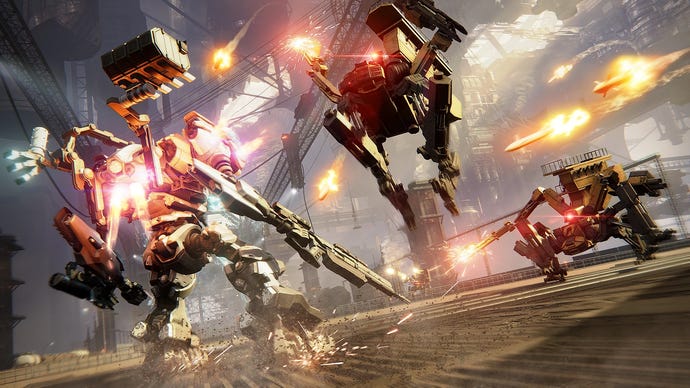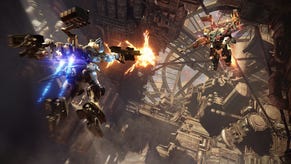Armored Core 6: Fires of Rubicon tips from someone who never played an Armored Core before
Welcome to the Armored Core 6: Fires of Rubicon club. I just joined myself, and I'll be your guide.
Friends, I have seen the mechanised light of Armored Core. As a big fan of everything Souls-y made by FromSoftware, I never actually played any of the Armored Core games. But I like mechs, and Armored Core 6: Fires of Rubicon seemed like a soft reboot - the perfect opportunity for a newcomer to the series to jump in.
Connor argued that Fires of Rubicon is a perfect game for Dark Souls fans to play, and I can see why. You might even agree with Josh, who suggested in our review that the game doesn’t go far enough.
Regardless of all the takes of varying temperatures, Armored Core 6: Fires of Rubicon is a game that, unsurprisingly, doesn’t explain a lot of itself. If you’re especially new, like myself, you’re going to be even more confused by things like weight limits, energy consumption, the differences between cores/legs, and a whole list of specs that affect your moment-to-moment gameplay.
So, allow me, an Armored Core newbie, to guide you through a few of my observations (tips) and save you a lot of frustration, and guesswork.
Remap the buttons for boost and quick boost immediately
Okay, this one is going to be more of a personal preference, but I found it much easier to have quick boost (dodge) on Circle/B, similar to how it works in Souls-like games. The standard boost, which lets your AC glide across the ground, can instead be mapped to Square/X.
The standard boost is always on a toggle, so it’s more intuitive to leave it off where the dodge button usually sits, as you’ll be relying on it frequently in boss fights - and when you want to avoid enemy fire and quickly get behind cover.
This can be done from the controls menu, where you can also pick from different default setups, or create your own. It’s not as malleable as you might expect, but you can make it work for you.
Ammo and healing items are limited, don’t spam them
Armored Core is a mech game where you can slide across the ground, fly, lob shots over cover, and lock onto multiple targets. As arcade-y as it may appear, Armored Core can be very serious about the simulation of certain elements.
This is especially clear in how the game treats ammo. Every weapon you load up with has a finite number of shots, and it’s quite easy to run out of one (or all) of them as you play if you’re not careful.
When a weapon (attached to an arm) runs out of ammo, your attack simply turns into… a punch. I have found that out in the worst possible way a few times, and I can tell you, it’s not fun. While certain missions allow you to re-supply somewhere along the way, those resupply drones almost always show up before big fights, so don’t count on them to save you as you roam around the world.
The same is true for repair kits, the game’s version of healing items. You can’t replenish them mid-mission, unless the game wants you to before a big fight. While it’s fun to whiteknuckle the rest of a mission with zero kits and sub-50% health, I’d rather have some fallback if I need it.
If you think you’ve used up a lot of ammo already, or ran out of most of your healing items, don’t be afraid to restart the mission, or from the most recent checkpoint. Doing so always respawns you back with full ammo.
The compass is more useful than it might appear
The Armored Core 6 compass, found at the bottom of the screen, has loads of useful information that can give you the upper hand in fights. This is especially true when dealing with multiple targets at different elevation levels.
The compass shows enemies as red squares, and indicates whether they’re above or below you. ACs with elevation on you will make things very difficult, especially if you can’t find cover. It’s always better to prioritise elevated/stationary targets before dealing with the rest.
In one of the missions, you’re going to spawn and immediately find large column of artillery units stationed on the side of a dam, shelling you endlessly. I couldn’t find a way to deal with ground targets while this barrage was ongoing, so I had to cut through everyone just to get rid of these artillery columns.
Indeed, the camo of some of those targets can make them very difficult to see, so you wouldn’t know to look for them until you get hit. This is why it’s best to keep an eye on your compass before diving in. The compass has also helped me keep my guard up when I’m looking for one final AC that I know is nearby, but can’t quite see.
Spam that scan button
Speaking of hidden enemies, scanning in Armored Core 6 is one of the best tools at your disposal. You’ll come to realise that intel is a major part of the battle here. The scan has a cooldown, but it’s brief enough that it can be spammed relatively often.
The radius of the pulse is fairly generous, too, and targets stay highlighted for a few seconds. Scanning is essential indoors, because it’s going to reveal ACs hiding and waiting to ambush you. One particular mission will pit you against ACs with active camo, which you can only (briefly) see by highlighting them through the scan.
The scan is mapped to down on the dpad by default, and you should absolutely make it a core part of your button rotation.
You can surprise enemy ACs in the open world
It might surprise (heh) you to learn that not all ACs in a mission will be aware of your presence in Armored Core 6. You typically start a mission far enough away from enemies, which gives you a chance to get the lay of the land, and plot a path through enemy ACs.
But it also helps to know that there’s such a thing as surprising enemies in this game. In fact, if you send out a scan and reveal an enemy, the HUD will highlight which of them are unaware of your presence, which makes it easier to sneak up on them.
This is especially useful if they have armour at the front, and you want to start the fight with a few nice shots to their unarmoured back. Better yet, if you have elevation on them, you can practically stagger them with your opening salvo, buying you enough time to get in and land some juicy critical hits before they even know what hit them.
This typically works on non-boss and mini-bosses, for obvious reasons - but the strategy of using the terrain to your advantage, together with constant scans, never goes out of style in this game.
.png?width=690&quality=70&format=jpg&auto=webp)
Play the training missions for free parts
As you make progress through Armored Core 6, more and more of the game’s training missions will be unlocked. The game will alert you once they become available. There aren’t that many of them, and they’re fairly easy to complete.
You should definitely play training missions as soon as they appear in your game for a few key reasons. For one, they’re great at familiarising you with the common tactics, and some of the AC lingo you may not be familiar with.
Later on, each training mission will focus on a particular AC archetype and explain why, and when you’d want to use them, which, other then give you build ideas, also lets you test out their effectiveness freely. Once you finish a mission, the game rewards you with free parts, and they’re typically from the very AC you just finished playing as.
Focus on the main objective, you can always come back later for anything else
Missions in Armored Core 6 are linear. There are limits to what you can explore, both horizontally and vertically. Every mission has a main objective, and the mission immediately ends when that objective is complete.
If you feel good about your build and your chances, you can mop the zone of every enemy AC for that nice pay bonus before deciding to tackle the main reason why you’re there. This won’t always work out well for you, however.
But, if you want the most efficient way of getting through a mission simply go after the main objective and finish the mission. Even if you’re being shot at by enemies, the ending cutscene will still play as you’re taken back to the menu.
That said, you also want to replay missions…
Replaying missions is always a good way to earn cash (and fame)
One of the best ways to make extra money in Armored Core 6 is to replay missions. It’s a good way to clear any side objectives you might have missed, and an even better way to earn a bonus on the number of enemies you kill.
It goes without saying that your second or third time through a mission will always go smoother than your first run, because you’ll already be familiar with all the surprises, twists and turns that await.
Replaying missions is also a good way of testing the limits of your AC, particularly if you just put together a new build. Certain bosses, and mini-bosses in Fires of Rubicon are specifically designed for a certain archetype of AC. You’ll know if you struggled against them with your old, mis-matched build.
Once you finish the campaign, replaying missions becomes a major source of income to fuel all your wild mech building ideas. Doing so is also how you can go on the hunt for any of the bounties (loghunt) targets you missed on your first go.
Some missions don’t have checkpoints
This is just a general PSA to let you know that some missions in Fires of Rubicon simply do not have any checkpoints. Dying at any point will sadly send you all the way back to the start.
I couldn’t find a rhyme or reason for which missions do, and which do not, but it’s always a good idea to pause the game and check whether the ‘Restart from checkpoint’ option is greyed out after you make some headway through a mission.
This is one of Armored Core 6’s most frustrating aspects, so it helps to know that it’s a possibility before you rely on reloading a checkpoint that does not exist.
You can preview weapons in the store before buying
Depending on how well you’ve been doing, and following the above tips, there will come a point when you’re flush with cash in Fires of Rubicon. Typically, multiple successful missions will charge your account with the necessary funds to buy new weapons, frame parts, legs, generators and everything else you can use to build your dream AC.
And, you don’t actually need to buy the part in question to try it out. The store offers a preview video of what the weapon does, available by hitting Square/X. A small video window will pop up showing you what to expect, and it’s perfect if you, say, like the power of a weapon but feel the rate of fire will be too low, and you don’t want to have to spend money to find out.
Obviously, nothing beats actually testing out the weapon yourself, so you may just end up buying it to find out for sure.
Learn what warning tones are trying to tell you (there are many)
The mark of a good AC pilot lies in their ability to respond well to events in combat. And you can’t do that without being fully aware of what each sound cue, and warning tone does in the game. Armored Core has a few of those, and they’re simply designed to alert you to the status of your AC, your own armaments and so on.
There’s a sound that plays when you’re about to overheat, run out of ammo, successfully lock onto an enemy and a few other things. But you need to know which of them is telling you that you’ve successfully locked onto an enemy, and which is simply advising you to take cover.
Load up a test Sortie from the main menu outside of missions and, well, play around so you can be sure what each warning tone is trying to tell you. In the heat of battle, you’re going to need to act on instinct, but you need to learn all the possible warning tones before you can do that effectively.
It’s all about those legs
Legs dictate most of what matters about your AC in Fires of Rubicon. This is a movement-heavy game, so you shouldn’t be surprised to learn that how your mech moves is mainly decided by the type of legs you have equipped.
For example, if you like to pop your head over cover and launch a few missiles/take a few shots before quickly landing back behind cover, reverse-joint legs are perfect for the job. They offer high mobility, and unmatched speed, so they’re essential for light builds.
Even outside of the different speeds, and movement opportunities each leg type allows, some unlock entirely new ways to play, such as the tetrapods. Tetrapod legs let you hover over the battlefield, which means you get to stay in the air longer, and is a great way to always (literally) get the drop on your enemies, and definitely makes it easier to deal with flying units.
If there’s one part you should definitely pay attention to, it’s the legs.
It’s essential to save multiple builds with different setups
As your understanding of Armored Core build-crafting grows, so too will your need to experiment and create your own builds. Nothing is off the table there, so long as you stay within your energy and weight limits.
You’ll also gradually come across certain boss fights - not to mention certain other situations the game loves to throw you in, that can be quite difficult to navigate depending on your build. If the boss can only be hit from the back and you can’t outrun it, or jump behind it quickly enough before it starts facing towards you again, you probably won’t be able to take it down.
Likewise, if a flying boss is simply too fast to track, you may want a tougher build to eat up some of those hits while outputting enough damage to win that war of attrition. Fires of Rubicon makes it easy to save builds. You can even give each of them a name, and customise them with colours/decals and so on. It makes it easier to identify them from the list at a glance.
The game also lets you share your own builds, and browse the work of others - so don’t be afraid to experiment with different approaches. Launching a test Sortie doesn’t cost anything, either.





.png?width=291&height=164&fit=crop&quality=80&format=jpg&auto=webp)


